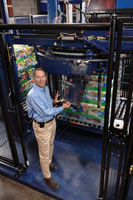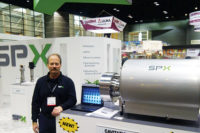
Patrick R. Lancaster III, chairman and product development consultant, Lantech Inc., Louisville, KY

Pat Lancaster stands next to the RS-6000, a high-speed stretch-wrapping machine engineered to resolve specific palletizing issues. Source: Lantech Inc.
The Lancaster brothers spent their boyhood as junkyard scavengers, culling components for bicycle-powered helicopters and other homegrown inventions. By the early ‘70s, their attention had shifted to unitized pallets, a material-handling option that typically relied on strapping or cumbersome plastic bags to stabilize a load. Bill and Pat devised a clamping system that allowed multiple layers of film to be wrapped around a pallet load, resolving issues that defeated earlier single-layer systems. Film-stretching innovations followed, and continuous-improvement efforts have resulted in less material use and greater containment force with each new generation of machines.
Pat Lancaster was raised in Louisville and majored in economics with a secondary emphasis in physics at Georgetown University. He earned an MBA at Golden Gate College and served six years as a US Air Force R&D contracting officer at Edwards AFB, negotiating contracts for Saturn rocket components and other leading edge technology. He subsequently returned to Louisville, where he joined his father’s firm, Superior Paper Co.
FE: How was palletizing used in material handling when your brother and you began your work?
Lancaster: North America discovered the strength of pallet shipping in the late ‘60s, precisely placing large plastic bags weighing up to 3 lbs. over a loaded pallet, then placing the load in an oven and shrinking the bag. It was the biggest productivity improvement since the cardboard box. Before that, manual floor loading of trucks with about 900 cases was the norm. It took two men a day to unload a truck. Pallets turned 900 cases into 22 loads that could be moved in 20 minutes.
First we developed an infrared tunnel for bag shrinking that was much cheaper than gas or electric ovens. Operating costs became an issue after the first oil embargo hit, though. Stretch wrapping was an energy-efficient alternative, cutting material use to a third and using one-hundredth the energy. It also was more easily automated. We invented prestretch in the late ‘70s, cutting the amount of film needed to secure a load by another 50%.
FE: Your brother and you supposedly developed your prototype over the kitchen table. Is that a corporate fable?
Lancaster: As much as it embarrasses me, that much of the story is true. Within two or three days of the “Aha!” moment, we had a mock up. It was so crude, no one else could see it, which was frustrating. People said things like, “Film is too thin to hold a 2,000-lb. load.” When we built the earliest machine, it was back to our junkyard days, with a rear wheel and brake from a Ford Falcon and a shock absorber from a Harley-Davidson.
FE: You attribute more recent mechanical innovations to studying what goes on in a plant. How has that impacted development work?
Lancaster: Until I retired as CEO in 1995, we were focused on features that sell, based on the feedback we received from end-users. It struck me that we understood precious little about the issues in the plant and what made the equipment easier to use. So when I stepped down as president, I put on jeans and went with our tech people to study what was going on. Someone noted, “Looking is so much more important than talking in seeking the truth.” Over the last 10 years, watching has driven innovations in machine guarding, worker protection and simplification of the machinery.
FE: What was the biggest eye opener from watching?
Lancaster: A lot of the improvements we made were almost serendipitous, but the one that had the biggest impact and no one had requested was the reduction in film breaks. One to five breaks per roll were common. At a plant with 18 stretch wrappers, there typically is a break every 15 minutes. With only three operators to tend to them, it’s more like stoking a stove than benefiting from automated material flow.
FE: How disciplined was the approach to solving the film-break issue?
Lancaster: Like most things I do, it didn’t happen in a very linear way. It started when I began studying what was going on in the plants. The cognitive recognition was probably three years ago, but data collection for Pareto charting came later and continues. We found two new sources of breaks yesterday. The way you thread the film on the machine can create a break on the next cycle. It probably occurs once in 10,000 cycles. That’s the level we’re at in root-cause analysis.
FE: Why weren’t film breaks an issue 20 years ago?
Lancaster: Increased speed, less film and reduced labor were the focus of improvement efforts. Breaks were accepted because people expected film to break. In South Africa, where the mean time to tire failure is 500 miles, people drive around with two or three spares. The guy who invented the radial tire didn’t understand that he was eliminating flat tires. That’s the arc our development work has taken: After several breakthroughs occurred, we came to realize today’s technology is limited by your ability to not break the film. Formalizing that in a continuous-improvement program has followed.
FE: How many break factors have been identified?
Lancaster: It’s on the order of 20. We’re not looking at film breaks per roll anymore but film breaks per week. The goal is one every month and a half.
Film clamping failures are frequently the root cause. Film quality, particularly because of roll damage in shipping and unwind issues at the end of the roll, is the second biggest cause. Sharp pallet or carton corners also produce film tears. Failures in wrapping controls, mechanical alignment issues and threading errors also rank high on the Pareto chart. We designed a cut-and-clamp system that addresses some of the leading causes. It’s all mechanical, no servos or sensors. With current electronic prestretch drives, a slip ring transmits power, and any power interruption results in film breaks. That’s the number one cause. With the mechanical system, there’s no slip ring, and you can accelerate from a stop position to 60 RPMs without a break. That hasn’t been possible with electronics.
FE: How does 60 RPMs compare with earlier stretch wrappers?
Lancaster: I set 60 RPMs as a goal without a counterweight, and the innovation team hated me for it. We spent almost two years developing a Kevlar-reinforced carbon-fiber bearing ring with the requisite flatness and roundness. Early prototypes had grease blowing out of the reducer-bearing seals because of the centrifugal forces. The OEM had never experienced that problem because those speeds had never been achieved before. You have to be stubborn and a little nuts to overcome the types of problems we encountered.
Keep it simple is a powerful maxim, though, and we kept that in mind. Every complexity adds potential for downtime. The final design still needs a motor to raise and lower the film roll, it still needs a motor to stretch the film, but that’s it. Other machines have 20 or more motors.
FE: How do you formalize your continuous-improvement efforts?
Lancaster: When it came to continuous improvement, I was a flavor of the year guy for years. We did the black belts, team T-shirts and so on, but we couldn’t see the quality of the product moving up or find the bottom-line benefit of customer satisfaction. In 1989, we started incorporating some of the principles of the Toyota Development System, and in 1992, we became real devotees. Now, I’m a Toyota fanatic.
We have mechanical and electrical skills on our innovation team, and we can draw on other areas of expertise as needed. But in Toyota’s concept, the chief engineer should be the person who understands best how the customer uses the product; the MIT engineer should work for him. The chief engineer for the Prius is probably a great driver who came up through the ranks and may or may not have an engineering degree.
